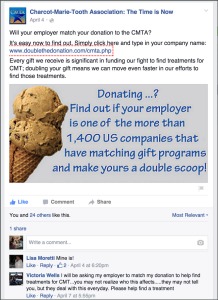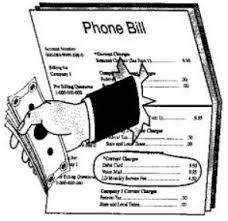Good morning, DonorDreams readers! As I’ve shared in recent posts, my work schedule has become chaotic in recent months thanks to a few fun and challenging contracts that I signed. Since there is only so much time in a day, I sometimes inadvertently end up dropping the ball with writing a blog post. I promised you that I will do my best to keep this blog platform a priority and try to engage guest bloggers to fill some of the gaps created by my schedule. This morning I’m grateful to Adam Weinger, who is the president of Double the Donation, for agreeing to be one of those guest bloggers. I hope you enjoy this morning’s post about online matching gift strategies. Here’s to your health! ~Erik
6 Tips to Increase Your Online Matching Gift Strategy
Letting your donors know about matching gift programs doesn’t have to be a headache. Having a great team and crafting an effective online presence will help you get the word out about matching gifts and will result in more donations for your nonprofit.
Here are 6 tips that will enable you to give your online gift matching strategies a boost.
1. Appoint a Matching Gift Coordinator
Before beefing up your online matching gift strategy, it’s a good idea to designate one person or a small team of people who will be able to effectively market matching gifts online. While the entire staff should be aware of matching gift programs, making one person the established go-to source for matching gifts can help streamline the online donation and matching gift process.
2. Raise Awareness on Your Website
When people visit your nonprofit’s website, they’re usually looking for information about your organization and ways to donate to your cause.
Why not use that opportunity to let them know about corporate giving programs such as matching gift programs?
For example, you can spread the word about matching gifts on your website in a variety of ways:
- Include matching gifts on your “ways to give” page. When potential or existing donors find their way to an online donation page, have a prominent link that points them in the direction of matching gift information.
- Consider implementing an entire page dedicated to matching gift programs. Creating a comprehensive page that lets donors know more about matching gift programs is a great way to give them the most information in one central location.
3. Update Your Website
Nothing can irritate a donor more than going to a nonprofit’s website and getting nothing but broken links and unhelpful pages. The most recent Millennial Impact Report found that over 30% of millennial employees who make donations do so online. Contributions made online are becoming increasingly popular due to the ease and accessibility of donation pages. Don’t miss out on getting these donations plus the matching gifts that go along with them by having a subpar website.
4. Inform Donors about Matching Gifts Throughout the Donation Process
Keeping individuals in the know about matching gifts at every stage of the donation process will help maximize the number of donors that look into doubling their donation.
Provide an option when they donate
If your donors are using your website to donate, use the opportunity to let them know about matching gifts while they’re giving. Offering donors an option to learn more about matching gifts while their contribution is being made will increase the chances that they’ll look into matching gifts.
For tips on making online donations easier, check out this article.
Use your confirmation page
Donors want to make sure their online donation went through without a hitch. Since they’ll be directed to the confirmation page anyway, it’s worthwhile to let donors know about matching gift programs, just in case they missed it on the actual donation page.
Thank You Email
You should always say thank you after receiving a donation, but you can also use your thank you email to let donors about matching gifts. Not only will they feel appreciated for giving to your organization, but they’ll also know more about doubling their contribution.
One idea: Send a short creative video in an email to let donors know you appreciate their gift and show them what your donation is going toward.
Check out these great tips on sending out thank you notes.
5. Pair up Wealth Screenings and Matching Gifts
Using wealth screenings and prospect research to get the most out of your existing donations can be the perfect way to make them go farther.
It’s essential to know who your donors are, who has greatest capacity to give, and who they’re connected to. And spending time learning about your donors or prospective donors will help you maximize the number of donations you receive, and better enable your organization to get the word out about matching gifts.
Learn more about wealth screenings and look into how they pair well with matching gifts.
6. Use Social Media
 With so many people posting updates, Tweeting the latest news, and hashtagging photos of their lunch, it’s a good idea to jump on the social media bandwagon and utilize different sites to promote matching gifts programs. Keeping the message short and sweet is the key, here. No one wants to read a novel when scrolling through their Facebook newsfeed.
With so many people posting updates, Tweeting the latest news, and hashtagging photos of their lunch, it’s a good idea to jump on the social media bandwagon and utilize different sites to promote matching gifts programs. Keeping the message short and sweet is the key, here. No one wants to read a novel when scrolling through their Facebook newsfeed.
The Charcot-Marie-Tooth Association has a perfect example of how to capture followers’ attention and let them know about matching gifts without overwhelming them with information. The picture highlights doubling donations by showing two scoops of ice cream and as well as using the “double scoop” pun to draw followers’ attention to matching gift information. The post also provides donors with a helpful link to find out whether or not their employer uses a gift matching program.
Learn more about using social media to promote matching gifts.
Using a combination of these different tools will help your nonprofit succeed in letting your donors know about matching gift programs, resulting in more donations for your organization.

 Slavery ended on December 6, 1865 when the 13th Amendment to the Constitution of the United States was ratified. In a nutshell, this means that people cannot own people anymore. I have a hard time juxtaposing this fact with what I hear some non-profit professionals sometimes say, which is: “. . . that is my donor“.
Slavery ended on December 6, 1865 when the 13th Amendment to the Constitution of the United States was ratified. In a nutshell, this means that people cannot own people anymore. I have a hard time juxtaposing this fact with what I hear some non-profit professionals sometimes say, which is: “. . . that is my donor“. Let’s face it . . . non-profit organizations typically have many competing priorities and projects usually going on simultaneously (e.g. supporting the annual fund, building a new building, renovating an existing space, endowing a program, etc).
Let’s face it . . . non-profit organizations typically have many competing priorities and projects usually going on simultaneously (e.g. supporting the annual fund, building a new building, renovating an existing space, endowing a program, etc).
 Last night I met with a non-profit board of directors, and we spent an hour talking about the “Three Stories You Need To Tell“. I centered the discussion around the
Last night I met with a non-profit board of directors, and we spent an hour talking about the “Three Stories You Need To Tell“. I centered the discussion around the  How many times have you been handed pages full of data at the start of any type of planning process (e.g. strategic planning, resource development planning, etc). You are typically asked to look for gaps in addition to organization strengths, weaknesses, opportunities and threats.
How many times have you been handed pages full of data at the start of any type of planning process (e.g. strategic planning, resource development planning, etc). You are typically asked to look for gaps in addition to organization strengths, weaknesses, opportunities and threats. After the assessment phase of any planning process is over, it is common for boards to spend time developing a vision for the future. It is upon this vision that goals, strategies, tactics and metrics are all built.
After the assessment phase of any planning process is over, it is common for boards to spend time developing a vision for the future. It is upon this vision that goals, strategies, tactics and metrics are all built.
 It seems like one common theme in my work with non-profit organizations is that “building consensus” is difficult. Getting everyone on the same page can be like herding cats. It was this reality that had me all tied in knots a few months ago as I was sitting down for the first time with my Philanthropy Day planning committee. We had lots of things to decide (e.g. event location, registration fees, training sessions, discussion panels, etc), and there was very little time to do so.
It seems like one common theme in my work with non-profit organizations is that “building consensus” is difficult. Getting everyone on the same page can be like herding cats. It was this reality that had me all tied in knots a few months ago as I was sitting down for the first time with my Philanthropy Day planning committee. We had lots of things to decide (e.g. event location, registration fees, training sessions, discussion panels, etc), and there was very little time to do so. Last month I sat down with an executive director and two board members to explore how I might be able to help their organization grow their organizational capacity. Over the course of an hour, we talked about all kinds of awesome things such as:
Last month I sat down with an executive director and two board members to explore how I might be able to help their organization grow their organizational capacity. Over the course of an hour, we talked about all kinds of awesome things such as: The people closest to your mission are board and staff members. So, when the organization is short on cash and cannot meet its payroll obligations, it is only natural to ask board members to dig a little deeper.
The people closest to your mission are board and staff members. So, when the organization is short on cash and cannot meet its payroll obligations, it is only natural to ask board members to dig a little deeper. Don’t pass the basket and ask smaller, low capacity donors. Identify your larger, more capable donors and schedule an in-person meeting to explain what has occurred and ask for their support.
Don’t pass the basket and ask smaller, low capacity donors. Identify your larger, more capable donors and schedule an in-person meeting to explain what has occurred and ask for their support. Accounts receivable can be any number of the following individuals/entities:
Accounts receivable can be any number of the following individuals/entities: If your organization finds itself in this mess, then the bank is probably not extending you additional credit. While managing your cash flow on the backs of your vendors is a bad thing to do, sometimes life presents you with a bunch of bad options.
If your organization finds itself in this mess, then the bank is probably not extending you additional credit. While managing your cash flow on the backs of your vendors is a bad thing to do, sometimes life presents you with a bunch of bad options.
![IMG_20150805_111547840_HDR[1]](https://donordreams.files.wordpress.com/2015/08/img_20150805_111547840_hdr1.jpg?w=300)
![IMG_20150805_105024312_HDR[1]](https://donordreams.files.wordpress.com/2015/08/img_20150805_105024312_hdr1.jpg?w=300)
![IMG_20150805_104819757[1]](https://donordreams.files.wordpress.com/2015/08/img_20150805_1048197571.jpg?w=300)
 For those who are curious, here are those 12 steps to a simple and effective face-to-face solicitation:
For those who are curious, here are those 12 steps to a simple and effective face-to-face solicitation: This morning’s video also reminded me of another YouTube video a friend sent me a few days ago. It is a montage of video clips featuring actor Matt Damon in the HBO television series “Entourage“. The YouTube video illustrates the emotions, fears, and mistakes associated with asking your friends and colleagues for a charitable contribution.
This morning’s video also reminded me of another YouTube video a friend sent me a few days ago. It is a montage of video clips featuring actor Matt Damon in the HBO television series “Entourage“. The YouTube video illustrates the emotions, fears, and mistakes associated with asking your friends and colleagues for a charitable contribution.![IMG_20150802_102350339_HDR[1]](https://donordreams.files.wordpress.com/2015/08/img_20150802_102350339_hdr1.jpg?w=300) A few days ago, I was in an airport trying to catch a connecting flight when I saw a poster advertisement for an international non-governmental organization (NGO) that provides medical services to children and families in third world countries. I took a picture of the portion of the advertisement that immediately caught my attention.
A few days ago, I was in an airport trying to catch a connecting flight when I saw a poster advertisement for an international non-governmental organization (NGO) that provides medical services to children and families in third world countries. I took a picture of the portion of the advertisement that immediately caught my attention.